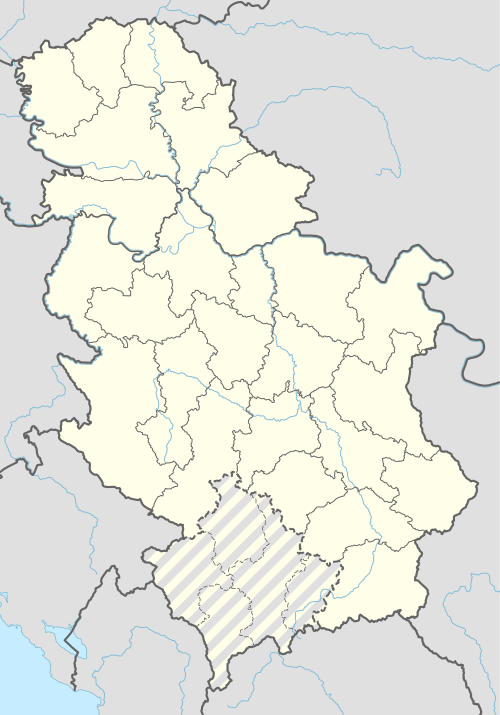Ugao
Ugao (Serbian Cyrillic: Угао, Albanian: Uglli) is a village located in the municipality of Sjenica, southwestern Serbia. According to the 2011 census, the village has a population of 545 inhabitants.
Ugao Угао Uglli | |
|---|---|
Village | |
 Ugao | |
| Coordinates: 43°03′N 20°03′E | |
| Country | |
| District | Zlatibor District |
| Municipality | Sjenica |
| Area | |
| • Total | 27.64 km2 (10.67 sq mi) |
| Elevation | 1,269 m (4,163 ft) |
| Population (2011)[2] | |
| • Total | 545 |
| • Density | 20/km2 (51/sq mi) |
| Time zone | UTC+1 (CET) |
| • Summer (DST) | UTC+2 (CEST) |
Ugao is one of three Albanian villages (Boroštica, Doliće and Ugao) in the Pešter region. Factors such as some intermarriage undertaken by two generations with the surrounding Bosniak population along with the difficult circumstances of the Yugoslav wars (1990s) made local Albanians opt to refer to themselves in censuses as Bosniaks. Elders in the village still have a degree of fluency in the language.[3]
References
- "Насеља општине Сјеница" (PDF). stat.gov.rs (in Serbian). Statistical Office of Serbia. Retrieved 12 October 2019.
- "2011 Census of Population, Households and Dwellings in the Republic of Serbia: Comparative Overview of the Number of Population in 1948, 1953, 1961, 1971, 1981, 1991, 2002 and 2011, Data by settlements" (PDF). Statistical Office of Republic Of Serbia, Belgrade. 2014. ISBN 978-86-6161-109-4. Retrieved 2014-06-27.
- Andrea Pieroni, Maria Elena Giusti, & Cassandra L. Quave (2011). "Cross-cultural ethnobiology in the Western Balkans: medical ethnobotany and ethnozoology among Albanians and Serbs in the Pešter Plateau, Sandžak, South-Western Serbia." Human Ecology. 39.(3): 335. "The current population of the Albanian villages is partly “bosniakicised”, since in the last two generations a number of Albanian males began to intermarry with (Muslim) Bosniak women of Pešter. This is one of the reasons why locals in Ugao were declared to be “Bosniaks” in the last census of 2002, or, in Boroštica, to be simply “Muslims”, and in both cases abandoning the previous ethnic label of “Albanians”, which these villages used in the census conducted during “Yugoslavian” times. A number of our informants confirmed that the self-attribution “Albanian” was purposely abandoned in order to avoid problems following the Yugoslav Wars and associated violent incursions of Serbian para-military forces in the area. The oldest generation of the villagers however are still fluent in a dialect of Ghegh Albanian, which appears to have been neglected by European linguists thus far. Additionally, the presence of an Albanian minority in this area has never been brought to the attention of international stakeholders by either the former Yugoslav or the current Serbian authorities."
This article is issued from Wikipedia. The text is licensed under Creative Commons - Attribution - Sharealike. Additional terms may apply for the media files.